Going from the letter "P" to a sequence of points involves several steps. You'll need to use Core Text.
Create a CTFont. Since iOS 7, you can use a UIFont where a CTFont is needed (they are “toll-free bridged”). You can also create a CTFont directly from a CGFont using the CTFontCreateWithGraphicsFont function, or by name using CTFontCreateWithName (or using a few other methods).
Get the glyphs for the letter using the CTFontGetGlyphsForCharacters function. For the letter "P" there should be just one glyph. For some characters in non-English scripts you may get multiple (combining) glyphs.
Use the CTFontCreatePathForGlyph function to get a CGPath for the glyph.
Use CGPathApply to enumerate the elements of the path.
Convert each line, quad curve, and cubic curve element of the path to a sequence of points. Apple doesn't provide any public API for doing this. You'll need to do it yourself. For straight line elements it's easy. For curve elements, you will need to do some research if you don't already know how to render a Bézier curve. For example, see convert bezier curve to polygonal chain?.
We can experiment with this easily in a Swift playground:
import UIKit
import CoreText
import XCPlayground
let font = UIFont(name: "HelveticaNeue", size: 64)!
var unichars = [UniChar]("P".utf16)
var glyphs = [CGGlyph].init(repeating: 0, count: unichars.count)
let gotGlyphs = CTFontGetGlyphsForCharacters(font, &unichars, &glyphs, unichars.count)
if gotGlyphs {
let cgpath = CTFontCreatePathForGlyph(font, glyphs[0], nil)!
let path = UIBezierPath(cgPath: cgpath)
print(path)
XCPlaygroundPage.currentPage.captureValue(value: path, withIdentifier: "glyph \(glyphs[0])")
}
Result:
<UIBezierPath: 0x7fbc89e0d370; <MoveTo {11.072000000000001, 23.808}>,
<LineTo {11.072000000000001, 40.576000000000001}>,
<LineTo {22.975999999999999, 40.576000000000001}>,
<QuadCurveTo {30.560000000000002, 38.432000000000002} - {28.16, 40.576000000000001}>,
<QuadCurveTo {32.960000000000001, 32.192} - {32.960000000000001, 36.288000000000004}>,
<QuadCurveTo {30.560000000000002, 25.920000000000002} - {32.960000000000001, 28.096}>,
<QuadCurveTo {22.975999999999999, 23.808} - {28.16, 23.744}>,
<Close>,
<MoveTo {4.992, 45.695999999999998}>,
<LineTo {4.992, 0}>,
<LineTo {11.072000000000001, 0}>,
<LineTo {11.072000000000001, 18.687999999999999}>,
<LineTo {25.024000000000001, 18.687999999999999}>,
<QuadCurveTo {35.488, 22.208000000000002} - {31.936, 18.623999999999999}>,
<QuadCurveTo {39.039999999999999, 32.192} - {39.039999999999999, 25.792000000000002}>,
<QuadCurveTo {35.488, 42.143999999999998} - {39.039999999999999, 38.591999999999999}>,
<QuadCurveTo {25.024000000000001, 45.695999999999998} - {31.936, 45.695999999999998}>,
<Close>

